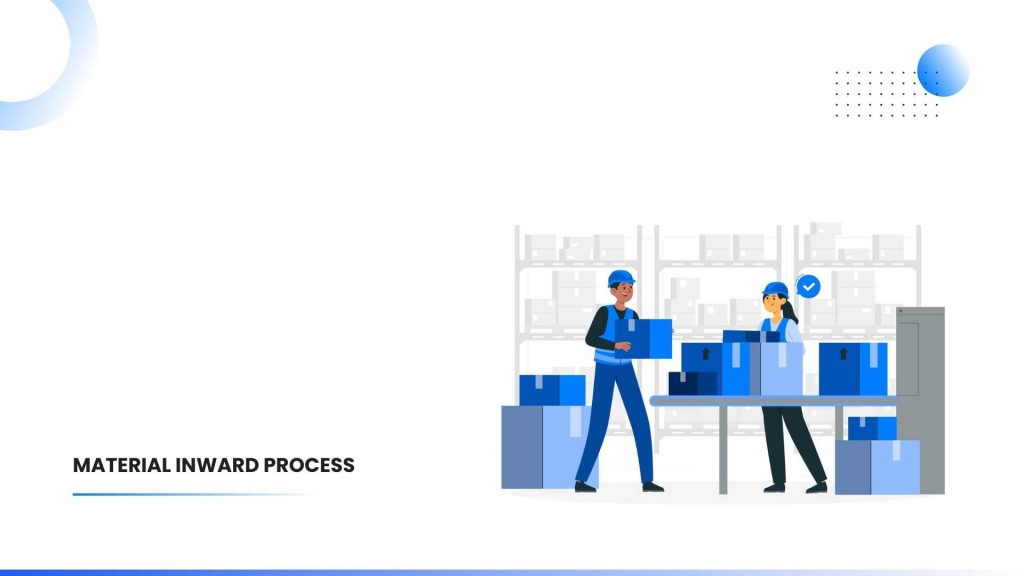The “Material Inward” or “Material Incoming” process involves receiving materials from a company. This process entails physically receiving the goods, comparing them to purchase orders or invoices, and recording the arrival of the materials in the company’s records.
Material Inward Process
The material inward process is a collaborative endeavor, necessitating the active involvement of the inventory, procurement, warehouse, and quality control teams. Each team’s contribution is vital, ensuring the efficient execution of the material inward process. A typical material inward process involves:
Assessment of Materials Required:
The calculation of material requirements for different types, such as consumables, spare parts, raw materials, are determined by evaluating the current inventory levels and the materials needed. Material requirements vary based on material type, production, and maintenance plans.
Purchase Order:
The procurement department generates a purchase order that includes specific details such as make/model/type, quantity, and other relevant specifications.
Goods Arrival:
The supplier delivers the goods/materials to the factory premises in neatly packed containers/packages, which are chosen based on the nature of the materials ordered.
Matching:
The received materials are checked against a packing list or bill of lading and inspected for any damages that may have occurred during transit.
Inspection and Quality Check:
Materials undergo inspection and quality checks to verify their compliance with the required specifications. Samples are tested and analyzed as needed to ensure quality standards are met.
Reconciliation and Rejection:
Materials are accepted into the inventory upon completion of inspection and quality checks. However, if there are any discrepancies in terms of quality or quantity, manufacturers have the right to reject the delivery and notify the suppliers to address and resolve the issues.
Inventory Update:
When materials are accepted, inventory records must be updated to reflect the new stock levels. It will ensure accurate inventory information & help plan production schedules properly.
Record Keeping:
Effective record-keeping is essential to the material inward process. Detailed records must be maintained at each stage, from the placement of the purchase order to the receipt of materials, inspection results, quality reports, and any identified deviations or issues. Conversely, complete or accurate records can result in significant concerns such as reduced visibility, lower productivity, and increased costs.
ERP helps increase the efficiency of Material Incoming Process
An ERP system improves material inward process and record keeping in manufacturing by the following means:
Automation: An ERP system automates and streamlines processes, facilitating real-time recording and tracking. It significantly reduces the likelihood of manual errors and omissions.
Integration: The ERP system integrates all departments and functions for seamless information flow and accurate record-keeping.
Purchase Order Management: The ERP system automates procurement processes and provides alerts and reminders for approvals, thereby reducing manual effort, increasing records accuracy, and expediting the purchase process.
Quality Management: The ERP system captures inspection results and non-conformance details to ensure complete traceability and proper record retention.
Document Management & Access: The ERP system offers a centralized database with real-time accurate information and allows easy access to information while moving.
Real-time Inventory Updates: The ERP software integrates gate management, quality inspection, and inventory modules to automatically update materials received, which ensures inventory accuracy.
Reporting and Analytics: The ERP system offers standard reports and trend analysis to monitor processes and improve decisions.
Compliance and Audit Support: The ERP system assists in maintaining historical data for audit purposes and ensuring compliance with regulations.
Conclusion:
Acumatica ERP transforms the material incoming process in manufacturing by offering various tools and functionalities. By streamlining workflows, providing real-time visibility into inventory levels, and integrating with supplier management systems, Acumatica enhances efficiency and accuracy.
Its advanced analytics capabilities enable proactive decision-making, while automation reduces errors and speeds up processing. Ultimately, Acumatica empowers manufacturers to gain better control, reduce costs, and enhance overall productivity in their incoming material process.

Vijay comes with a vast experience in ERP and enterprise solutions space with about 20 years of experience in various packaged application like Acumatica, SAP, Orion, Salesforce.com, SugarCRM and, SalesLogix.

